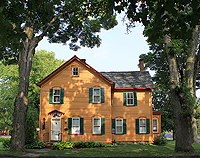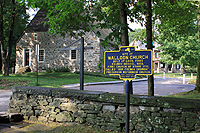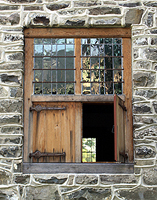| HudsonValleyAttractions.com | ||

|
||
|
Go Back 
Huguenot Street "National Historic Landmark"New PaltzUlster County |
|---|
| 845 255-1660 | ||||||||||||||||||
|
Historic Huguenot Street is located in New Paltz, New York in Ulster County. Set in the picturesque Hudson Valley, New Paltz is at the heart of a region rich in history, art and recreational activities. Whether you live in the area, are planning a day trip, or a vacation to New Paltz, Historic Huguenot Street is a place to experience a unique American story. The Story of Huguenot Street Click to enlarge photo of Huguenot Village Library in New Paltz, Ulster County.
Click to enlarge photo of Window Architecture in Huguenot Village Home.
During the entire period between the early part of the sixteenth century to 1787, thousands of Huguenots left their homes in France for other countries because of recurring waves of persecution. As Esther Forbes, wrote in Paul Revere and the World He Lived In (Boston: Houghton Mifflin Company, 1942):
"After decades of sojourn and relocation, a group of twelve Huguenot refugees from what is today northern France and southern Belgium and linked by family, religion, and friendship purchased nearly 40,000 acres along the Wallkill River in the Hudson Valley. They purchased this land from the native Esopus Indians, thus establishing a permanent home where they could pursue their Protestant faith free from religious and political persecution. They named the new town after die Pfalz, the region along the Rhine River where they had found temporary refuge before journeying to the new world." "Families began replacing their temporary homes in the early 1700s with stone houses along what is now known as Huguenot Street, seven of which survive today. The houses were added to over the first century or so of their existence to provide more comfortable living arrangements, and today the domestic environments of the colonial period and the early years of the Republic are preserved to inspire and to educate. While four of the houses are similar to their early appearance, the National Historic Landmark district also includes three original stone houses that were altered in the 1830s, the 1890s, and the 1940s, enabling three hundred years of history to be told on the street, displaying both continuity and change in American history." "In 1678, a group of Huguenot families established a community in the Hudson Valley of New York in the hope of creating a home where they could worship as they chose. In 1894, their descendants formed what is now Historic Huguenot Street to protect their legacy in the buildings, objects, and stories they left behind. We have taken an important step in strengthening our commitment to that historical mission, and the men and women who forged it, by introducing a new guest experience unlike any historic site in the region." "See Huguenot Street come alive with fresh interpretations of the historic houses, new tours across the settlement, and a diverse range of special programs. We've introduced different ways of engaging our guests to better connect them with the history and heritage of this special place. It is all driven by a commitment to a central, unifying theme: identity - how it's formed and shaped by challenges and conflict, what it meant to the Huguenots and their descendants, and why it matters to us today. Huguenot Street was called home by Indian, French, Dutch, African, English, and other men and women, all of whom played key roles in creating a new identity as Americans. Here, our guests become part of that story." Source: Historic Huguenot Street. Press blue button for more about Huguenot Street and the Huguenot Historical Society. Kids Things to Do at Huguenot Street Educational programs Learn about culture and history of Huguenot Street Tour historic homes
Location: New Paltz
| |||||||||||||||||||
 Huguenot Street "National Historic Landmark"
Huguenot Street "National Historic Landmark"





